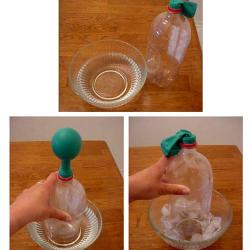Source Institutions
Add to list Go to activity
Activity link broken? See if it's at the internet archive

Learners cover a bottle with a balloon. When they immerse the bottle in warm water, the balloon inflates. When they immerse the bottle in a bowl of ice, the balloon deflates. Learners understand that warm air is less dense than cool air (it has the same mass, but more volume). This is one of three demonstrations investigating convection currents and their effects on weather and air pollution. Resource contains vocabulary definitions and suggestions for assessment, extensions, and scaling for different levels of learners.
- Under 5 minutes
- 5 to 10 minutes
- 1 cent - $1 per group of students
- Ages 8 - 14
- Activity, Demonstration
- English
Quick Guide
Materials List (per group of students)
- 1 empty, two-liter plastic bottle
- 1 balloon
- 1 large bowl
- Hot water
- Ice
Subjects
-
Earth and Space Science
-
Earth Processes
- Weather and Climate
-
Earth Structure
- Atmosphere
-
Earth Processes
-
Engineering and Technology
-
Engineering
- Civil Engineering
- Environmental Engineering
-
Engineering
-
Life Sciences
-
Ecology
- Human Impact
-
Ecology
-
Physical Sciences
-
States of Matter
- Gases
-
Structure and Properties of Matter
- Mass and Weight
- Volume and Density
-
States of Matter
Audience
To use this activity, learners need to:
- see
- touch
Learning styles supported:
- Involves hands-on or lab activities
Other
Includes alignment to state and/or national standards:
This resource is part of:
Access Rights:
- Free access
By:
- Kolenbrander, Amy ; Yowell, Janet ; Mach, Natalie ; Schaefer Zarske, Malinda ; Carlson, Denise ; Kotys-Schwartz, Daria
Source Collection
- TeachEngineering
Rights:
- All rights reserved, Regents of the University of Colorado, 2004
Funding Sources:
- Fund for the Improvement of Postsecondary Education (FIPSE)
- U.S. Department of Education
- National Science Foundation, 0226322
